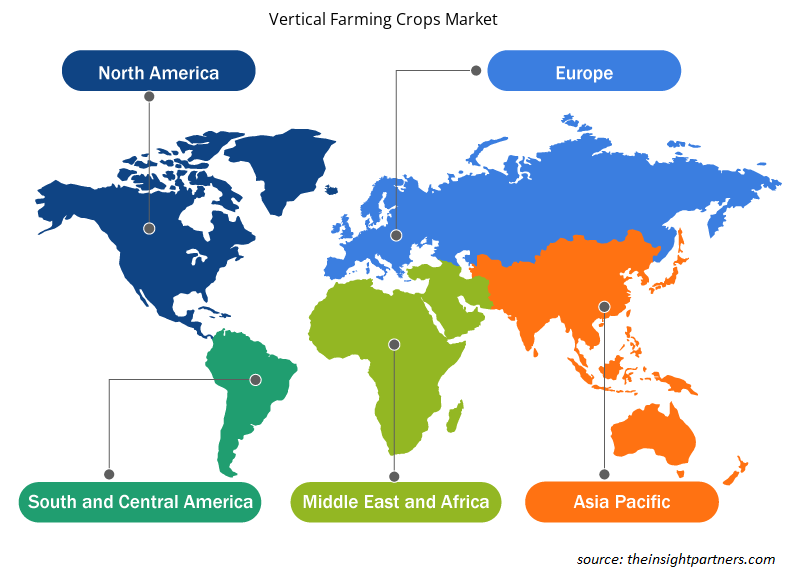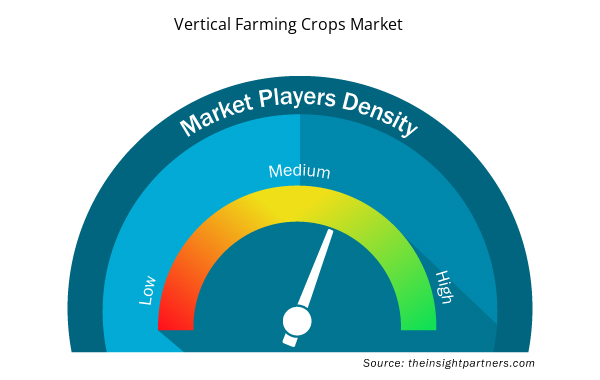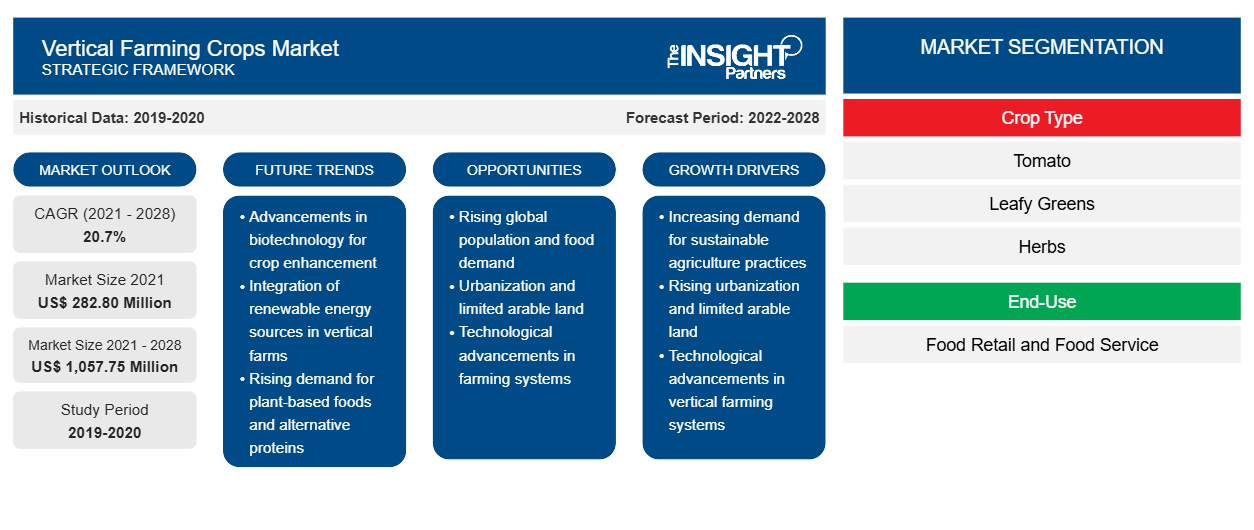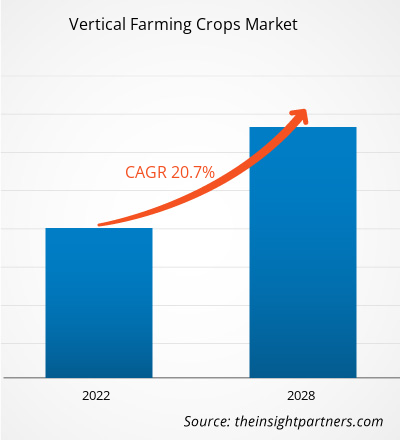[研究报告] 2021 年垂直农业作物市场价值 2.828 亿美元,预计到 2028 年将达到 10.5775 亿美元。预计 2021 年至 2028 年的复合年增长率为 20.7%。
垂直农业是指在由营养介质组成的托盘中垂直堆叠种植农作物。这是一种现代农业技术,种植农作物时不使用土壤或土地。此外,它不使用传统农业实践中通常使用的农药、化学肥料或其他合成材料。在耕地短缺的城市地区, 垂直农业正被越来越多地采用。
预计在预测期内,亚太地区将以全球垂直农业作物市场最快的复合年增长率增长。推动市场发展的主要因素是技术创新和对有机食品的需求不断增加。亚太地区的人口正在急剧增加。人口增长刺激了粮食需求,这进一步为垂直农业作物市场参与者提供了机会。此外,城市化进程的加快和现代农业实践的日益普及也在推动市场的发展。
此外,主要的垂直农业作物市场参与者正在积极关注创新。主要公司正在大力投资研发,并采用新兴技术来提高产量。例如,总部位于悉尼的初创公司 PodPlants 开发了轻便的便携式垂直花园,并凭借其独特的技术赢得了澳大利亚创新挑战赛。预计此类技术进步将在未来一段时间内推动区域市场增长。
定制此报告以满足您的需求
您可以免费定制任何报告,包括本报告的部分内容、国家级分析、Excel 数据包,以及为初创企业和大学提供优惠和折扣
- 获取此报告的关键市场趋势。这个免费样品将包括数据分析,从市场趋势到估计和预测。
COVID-19 对垂直农业作物市场的影响
COVID-19 疫情给各行各业带来了前所未有的挑战,全球食品和饮料行业也不例外。由于封锁、旅行禁令和制造厂关闭,供应链严重中断,导致销售额下降。此外,由于原材料和劳动力短缺,制造业面临产品供应短缺。然而,由于对本地生产、新鲜和有机产品的需求,垂直农作物市场实现了正增长。此外,个人健康意识的增强预计将在未来几年为垂直农作物带来盈利增长机会。
市场洞察
人工智能控制的垂直农场日益流行
人工智能控制的垂直农场通过提供与作物生长模式相关的数据,帮助种植者优化作物产量,包括哪些作物产量更高、作物所需的气候条件以及其他此类因素。种植者可以分析这些数据并采取必要的措施来提高产量。人工智能 (AI) 可以帮助该行业应对气候变化和资源可用性低等最大挑战,从控制主要作物生长到预测哪些作物产量更高。人工智能也在崛起,目前已有 1,600 多家初创企业,总投资额达到数百亿美元。人工智能控制的机器人监测植物生长情况,不断调整环境因素,以确保更高的效率和经济产出。因此,人工智能 (AI) 和物联网 (IoT) 预计将成为垂直农业作物市场的主要趋势。
作物类型洞察
根据作物类型,垂直农业作物市场细分为西红柿、绿叶蔬菜、香草和其他。绿叶蔬菜部分在 2019 年占据了最大的市场份额,香草部分预计在预测期内将在市场上实现最高的复合年增长率。绿叶蔬菜包括生菜、羽衣甘蓝、羽衣甘蓝、菠菜、水菜、甜菜叶和微型蔬菜。绿叶蔬菜适合室内种植,因为它们可以在相对较小的空间内快速生长。食品零售和食品服务业对新鲜绿叶蔬菜的需求不断增长,是推动该领域增长的主要因素之一。此外,“从农场到餐桌”的新鲜趋势也推动了对垂直种植绿叶蔬菜的需求。室内种植绿叶作物的研发支出激增,为市场增长提供了丰厚的机会。
最终用途洞察
根据最终用途行业,垂直农作物市场细分为食品服务和食品零售。食品零售部门在 2020 年占据了更大的市场份额。由于当地食品分销商、餐馆和咖啡馆以及快餐店对新鲜和高质量农产品的需求增加,预计食品服务部门在预测期内的复合年增长率将更高。此外,顾客越来越倾向于在餐馆和咖啡馆消费新鲜沙拉,这推动了食品服务行业对垂直农作物的需求。一些市场参与者正在与食品服务提供商合作以扩大业务。例如,2019 年 1 月,食品服务供应商 Van Gelder 和 PlantLab 达成合作,在 PlantLab 完全控制的垂直农业部门生产各种新鲜蔬菜。预计此类合作伙伴关系将在未来几年进一步推动市场发展。
农业技术见解
根据耕作技术,垂直农作物市场细分为水培、气培和鱼菜共生。水培部分在 2020 年占据了最大的市场份额,而气培部分预计在预测期内将在市场上实现最高的复合年增长率。在水培中,植物根部浸没在装有营养液的托盘中。在过去几年中,使用垂直水培系统的城市农业引起了广泛关注。这些水培农场可以使用最新技术优化植物生长,提供新鲜农产品,同时最大限度地减少用水量、土地空间、运输成本和农药使用量。水培通常可以生产出高质量的作物,通过采用人工智能 (AI) 和物联网 (IoT) 技术等新兴技术,种植者可以获得更好的作物产量。
全球垂直农业市场的一些主要参与者是 AeroFarms、Agricool、BOWERY FARMING INC.、CropOne、Infarm、Plantlab、Plenty Unlimited Inc.、Gotham Greens、MIRAI Co. Ltd. 和 BrightFarms。这些公司正在对新兴技术进行巨额投资,以提高农作物产量并以实惠的价格生产出高质量的农作物。
垂直农业作物市场区域洞察
Insight Partners 的分析师已详细解释了预测期内影响垂直农业作物市场的区域趋势和因素。本节还讨论了北美、欧洲、亚太地区、中东和非洲以及南美和中美洲的垂直农业作物市场细分和地理位置。

- 获取垂直农业作物市场的区域具体数据
垂直农业作物市场报告范围
| 报告属性 | 细节 |
|---|---|
| 2021 年市场规模 | 2.828亿美元 |
| 2028 年市场规模 | 10.5775亿美元 |
| 全球复合年增长率(2021 - 2028) | 20.7% |
| 史料 | 2019-2020 |
| 预测期 | 2022-2028 |
| 涵盖的领域 | 按作物类型
|
| 覆盖地区和国家 | 北美
|
| 市场领导者和主要公司简介 |
|
垂直农业作物市场参与者密度:了解其对业务动态的影响
垂直农业作物市场正在快速增长,这得益于终端用户需求的不断增长,这些需求源于消费者偏好的不断变化、技术进步以及对产品优势的认识不断提高等因素。随着需求的增加,企业正在扩大其产品范围,进行创新以满足消费者的需求,并利用新兴趋势,从而进一步推动市场增长。
市场参与者密度是指在特定市场或行业内运营的企业或公司的分布情况。它表明在给定市场空间中,相对于其规模或总市场价值,有多少竞争对手(市场参与者)存在。
在垂直农业作物市场运营的主要公司有:
- 航空农场
- 农业冷库
- Bowery 农业公司
- 作物一号
- 农场
免责声明:上面列出的公司没有按照任何特定顺序排列。

- 获取垂直农业作物市场顶级关键参与者概览
报告亮点
- 垂直农业作物市场的渐进式行业趋势可帮助参与者制定有效的长期战略
- 发达市场和发展中市场采用的业务增长战略
- 2019 年至 2028 年垂直农业作物市场的定量分析
- 全球垂直农业作物需求量估计
- PEST 分析可说明行业内买家和供应商的效率
- 了解竞争市场状况的最新发展
- 市场趋势和前景以及推动和制约垂直农业作物市场增长的因素
- 通过强调支撑商业利益的市场策略来协助决策过程,从而促进市场增长
- 垂直农业作物市场规模在不同节点的大小
- 市场的详细概述和细分,以及垂直农业作物行业动态
- 各地区垂直农业作物市场的规模以及良好的增长机会。
根据作物类型,垂直农业作物市场分为西红柿、绿叶蔬菜、香草等。根据最终用途行业,市场分为食品零售和食品服务。根据耕作技术,市场分为水培、气培和鱼菜共生。
- 历史分析(2 年)、基准年、预测(7 年)及复合年增长率
- PEST 和 SWOT 分析
- 市场规模价值/数量 - 全球、区域、国家
- 行业和竞争格局
- Excel 数据集



Report Coverage
Revenue forecast, Company Analysis, Industry landscape, Growth factors, and Trends

Segment Covered
This text is related
to segments covered.

Regional Scope
North America, Europe, Asia Pacific, Middle East & Africa, South & Central America

Country Scope
This text is related
to country scope.
常见问题
Based on end-user, the food service segment is projected to grow at the fastest CAGR from 2021 to 2028 owing to the rapidly expanding global food service sector coupled with rising demand for convenience, ready-to-consume, and healthy food products.
Based on crop type, the herbs segment is projected to grow at the fastest CAGR over the forecast period owing to the growing demand for high-quality and fresh herbs such as mint, coriander, parsley, basil, rosemary, among others from food retail as well as food service sector.
In 2020, Europe held the largest share in the global vertical farming crops market. The rising adoption of technologically advanced farming techniques coupled with the increasing demand for pesticide-free, hygienically produced agricultural products are they key factors driving the market growth.
The major players operating in the global vertical farming crops market are AeroFarms, Agricool, Bowery Farming Inc., CropOne, Infarm, Plantlab, Plenty Unlimited Inc., Gotham Greens, MIRAI Co., Ltd., and BrightFarms, among others.
Based on farming technique, the hydroponics segment held the largest market share in 2020. Hydroponics involves submerging the plant roots in trays containing nutrient solutions. In hydroponics, 90% less water is utilized compared to traditional agriculture methods. The rising popularity of hydroponics over conventional agricultural practices owing to its benefits is primarily driving the segment’s growth.
Vertical farming crops are crops grown in vertically stacked containers or trays containing nutrient media. Crops such as tomatoes, leafy greens, herbs, berries, bell peppers, cucumber, among others are majorly grown using vertical farming techniques. Hydroponics, aeroponics, and aquaponics are some of the prominent vertical farming methods. Food retail and food service sectors are the key end-users of vertical farming crops.
Trends and growth analysis reports related to Consumer Goods : READ MORE..
The List of Companies - Vertical Farming Crops Market
- AeroFarms
- Agricool
- Bowery Farming Inc.
- CropOne
- Infarm
- Plantlab
- Plenty Unlimited Inc.
- Gotham Greens
- MIRAI Co., Ltd.
- BrightFarms
The Insight Partners performs research in 4 major stages: Data Collection & Secondary Research, Primary Research, Data Analysis and Data Triangulation & Final Review.
- Data Collection and Secondary Research:
As a market research and consulting firm operating from a decade, we have published and advised several client across the globe. First step for any study will start with an assessment of currently available data and insights from existing reports. Further, historical and current market information is collected from Investor Presentations, Annual Reports, SEC Filings, etc., and other information related to company’s performance and market positioning are gathered from Paid Databases (Factiva, Hoovers, and Reuters) and various other publications available in public domain.
Several associations trade associates, technical forums, institutes, societies and organization are accessed to gain technical as well as market related insights through their publications such as research papers, blogs and press releases related to the studies are referred to get cues about the market. Further, white papers, journals, magazines, and other news articles published in last 3 years are scrutinized and analyzed to understand the current market trends.
- Primary Research:
The primarily interview analysis comprise of data obtained from industry participants interview and answers to survey questions gathered by in-house primary team.
For primary research, interviews are conducted with industry experts/CEOs/Marketing Managers/VPs/Subject Matter Experts from both demand and supply side to get a 360-degree view of the market. The primary team conducts several interviews based on the complexity of the markets to understand the various market trends and dynamics which makes research more credible and precise.
A typical research interview fulfils the following functions:
- Provides first-hand information on the market size, market trends, growth trends, competitive landscape, and outlook
- Validates and strengthens in-house secondary research findings
- Develops the analysis team’s expertise and market understanding
Primary research involves email interactions and telephone interviews for each market, category, segment, and sub-segment across geographies. The participants who typically take part in such a process include, but are not limited to:
- Industry participants: VPs, business development managers, market intelligence managers and national sales managers
- Outside experts: Valuation experts, research analysts and key opinion leaders specializing in the electronics and semiconductor industry.
Below is the breakup of our primary respondents by company, designation, and region:

Once we receive the confirmation from primary research sources or primary respondents, we finalize the base year market estimation and forecast the data as per the macroeconomic and microeconomic factors assessed during data collection.
- Data Analysis:
Once data is validated through both secondary as well as primary respondents, we finalize the market estimations by hypothesis formulation and factor analysis at regional and country level.
- Macro-Economic Factor Analysis:
We analyse macroeconomic indicators such the gross domestic product (GDP), increase in the demand for goods and services across industries, technological advancement, regional economic growth, governmental policies, the influence of COVID-19, PEST analysis, and other aspects. This analysis aids in setting benchmarks for various nations/regions and approximating market splits. Additionally, the general trend of the aforementioned components aid in determining the market's development possibilities.
- Country Level Data:
Various factors that are especially aligned to the country are taken into account to determine the market size for a certain area and country, including the presence of vendors, such as headquarters and offices, the country's GDP, demand patterns, and industry growth. To comprehend the market dynamics for the nation, a number of growth variables, inhibitors, application areas, and current market trends are researched. The aforementioned elements aid in determining the country's overall market's growth potential.
- Company Profile:
The “Table of Contents” is formulated by listing and analyzing more than 25 - 30 companies operating in the market ecosystem across geographies. However, we profile only 10 companies as a standard practice in our syndicate reports. These 10 companies comprise leading, emerging, and regional players. Nonetheless, our analysis is not restricted to the 10 listed companies, we also analyze other companies present in the market to develop a holistic view and understand the prevailing trends. The “Company Profiles” section in the report covers key facts, business description, products & services, financial information, SWOT analysis, and key developments. The financial information presented is extracted from the annual reports and official documents of the publicly listed companies. Upon collecting the information for the sections of respective companies, we verify them via various primary sources and then compile the data in respective company profiles. The company level information helps us in deriving the base number as well as in forecasting the market size.
- Developing Base Number:
Aggregation of sales statistics (2020-2022) and macro-economic factor, and other secondary and primary research insights are utilized to arrive at base number and related market shares for 2022. The data gaps are identified in this step and relevant market data is analyzed, collected from paid primary interviews or databases. On finalizing the base year market size, forecasts are developed on the basis of macro-economic, industry and market growth factors and company level analysis.
- Data Triangulation and Final Review:
The market findings and base year market size calculations are validated from supply as well as demand side. Demand side validations are based on macro-economic factor analysis and benchmarks for respective regions and countries. In case of supply side validations, revenues of major companies are estimated (in case not available) based on industry benchmark, approximate number of employees, product portfolio, and primary interviews revenues are gathered. Further revenue from target product/service segment is assessed to avoid overshooting of market statistics. In case of heavy deviations between supply and demand side values, all thes steps are repeated to achieve synchronization.
We follow an iterative model, wherein we share our research findings with Subject Matter Experts (SME’s) and Key Opinion Leaders (KOLs) until consensus view of the market is not formulated – this model negates any drastic deviation in the opinions of experts. Only validated and universally acceptable research findings are quoted in our reports.
We have important check points that we use to validate our research findings – which we call – data triangulation, where we validate the information, we generate from secondary sources with primary interviews and then we re-validate with our internal data bases and Subject matter experts. This comprehensive model enables us to deliver high quality, reliable data in shortest possible time.


 获取此报告的免费样本
获取此报告的免费样本